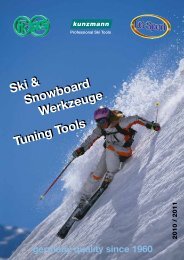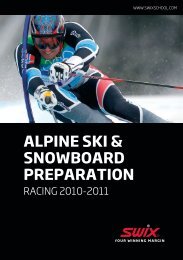NORDIC SKI PREPARATION
NORDIC SKI PREPARATION
NORDIC SKI PREPARATION
You also want an ePaper? Increase the reach of your titles
YUMPU automatically turns print PDFs into web optimized ePapers that Google loves.
APPLICATION OF BASE KLISTER (KB20)<br />
APPLICATION OF KLISTERS<br />
1.<br />
Sand the grip zone with #100 grit paper<br />
(T330 Sand Paper or T11 Combi Sanding Block)<br />
approx. 60-65 cm. We recommend sanding<br />
only along the length of the ski to prevent<br />
rounding of the ski side-edges. Sanding<br />
should always take place AFTER treatment of<br />
the glide zones, to avoid getting glide wax/<br />
powder into the kick zone. Wipe off dirt and<br />
base residue with Fiberlene (T150).<br />
2.<br />
Fasten a small piece of tape at the end of each<br />
kick zone to prevent any klister in the glide<br />
zones.<br />
3.<br />
Apply the base klister by holding the<br />
bottle upside-down and move it slowly<br />
along the ski on both sides of the groove.<br />
Distance between base and nozzle should be<br />
4-5 cm.<br />
4.<br />
Use the forefinger to remove klister in<br />
the groove.<br />
5.<br />
Then carefully use your thumb on each side<br />
of the groove to smooth out the klister. It is<br />
important that you smooth out the klister<br />
immediately after spraying.<br />
Remove the tape and let the klister dry for<br />
2-3 minutes. The ski is now ready for the next<br />
klister/wax layer (step 4 and 5 page 65).<br />
1.<br />
Sand the kick zone with #100 grit paper (T330<br />
Sand Paper or T11 Combi Sanding Block).<br />
Approx. 60-65 cm.<br />
Always do the sanding after the glidezones<br />
are all finished and brushed to avoid getting<br />
glidewax like Cera F powder into the kick zone.<br />
The kick zone for klister in top racing is generally<br />
about the same as for hard wax, somewhat<br />
longer than many realize.<br />
2.<br />
Apply the first layer of klister very thin,<br />
just covering the sandpapered area.<br />
KB20 or KR20 is a strong and durable klister<br />
normally selected as a base for KR30, KR35,<br />
KR50, KR60 and KR70. KR30 can also be used<br />
as the first layer of klister, i.e. as a base for<br />
KR60 or KR70 in wet snow conditions.<br />
3.<br />
Iron the first layer of klister carefully into the<br />
ski base. Thereby a much better contact is<br />
achieved between klister and ski.<br />
Let the ski cool.<br />
4.<br />
Apply the middle layer of klister. KR35 and<br />
KR30 are the most used. Apply it in a fish bone<br />
pattern. Use a heatgun lightly to<br />
soften it, and rub it in with the thumb to<br />
an even layer.<br />
Let the ski cool.<br />
5.<br />
Select and apply the klister of the day.<br />
Use a heatgun lightly and rub it in with the<br />
thumb to an even layer. Scrape the groove<br />
with the Groovescraper (T88).<br />
64 65





